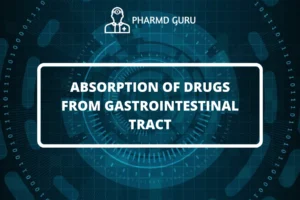Drug elimination refers to the removal of drugs from the body. It involves various processes, including metabolism and excretion, which play a crucial role in determining the duration and intensity of a drug’s effects. Understanding drug elimination is essential for optimizing dosing regimens and ensuring safe and effective use of medications. This article provides an overview of the processes involved in drug elimination, factors influencing drug clearance, and the importance of drug elimination in pharmacokinetics.
SCROLL DOWN TO THE BOTTOM OF THE PAGE FOR ACTUAL NOTES
Processes of Drug Elimination
Drug elimination primarily occurs through two main processes:
- Metabolism: Metabolism, also known as biotransformation, involves chemical modifications of drugs within the body. The liver is the primary organ responsible for drug metabolism, although other tissues, such as the kidneys and intestines, can also contribute. The goal of metabolism is to convert drugs into more polar compounds that are easier to excrete from the body.
- Excretion: Excretion involves the removal of drugs and their metabolites from the body. The primary routes of excretion are renal (via the kidneys) and biliary (via the liver and intestines). Renal excretion occurs through filtration, passive reabsorption, and active secretion into the urine. Biliary excretion involves the transport of drugs and metabolites into the bile, which is then eliminated through the feces.
Factors Influencing Drug Clearance
Several factors influence drug clearance, which is defined as the rate at which a drug is removed from the body. Understanding these factors is crucial for determining drug dosing regimens and predicting drug-drug interactions:
- Liver Function: The liver plays a central role in drug metabolism. Any condition that impairs liver function, such as liver disease or impaired hepatic blood flow, can affect drug clearance.
- Renal Function: Renal function is vital for drug excretion. Impaired kidney function can lead to reduced drug clearance, resulting in drug accumulation and potential toxicity. Dosage adjustments may be necessary for patients with renal impairment.
- Age: Drug clearance can vary with age. In general, drug clearance tends to be slower in neonates and the elderly due to differences in liver and kidney function. Age-related changes in drug metabolism and excretion should be considered when prescribing medications.
- Genetic Factors: Genetic variations in drug-metabolizing enzymes and drug transporters can influence drug clearance. Some individuals may have altered enzyme activity or reduced transporter function, leading to differences in drug clearance and response.
- Drug-Drug Interactions: Concurrent use of multiple drugs can affect drug clearance through various mechanisms. Some drugs can inhibit or induce drug-metabolizing enzymes, leading to altered clearance of co-administered drugs. Drug interactions should be carefully evaluated to prevent adverse effects or suboptimal therapeutic outcomes.
Importance of Drug Elimination in Pharmacokinetics
Drug elimination is a critical component of pharmacokinetics, which encompasses the study of how drugs move within the body. Understanding drug elimination parameters, such as clearance and half-life, helps healthcare professionals determine appropriate dosing regimens and ensure therapeutic efficacy. Drug elimination also plays a significant role in preventing drug accumulation, minimizing the risk of toxicity, and maintaining drug concentration within the desired therapeutic range.
ACTUAL NOTES




